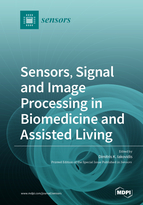Sensors, Signal and Image Processing in Biomedicine and Assisted Living
A special issue of Sensors (ISSN 1424-8220). This special issue belongs to the section "Biomedical Sensors".
Deadline for manuscript submissions: closed (31 March 2020) | Viewed by 88786
Special Issue Editor
Interests: signal/image processing and analysis; pattern recognition, data mining & machine learning; software engineering; bio-inspired algorithms & fuzzy systems; decision support & cognitive systems; challenging applications including but not limited to clinical informatics and biomedical engineering
Special Issues, Collections and Topics in MDPI journals
Special Issue Information
Dear Colleagues,
Sensor technologies are crucial in biomedicine, as the biomedical devices used for screening and/or diagnosis rely on their efficiency and effectiveness. Further enhancement of the sensor signals acquired, such as the noise reduction in the one-dimensional electroencephalographic (EEG) signals or the color correction in the endoscopic images, and their analysis by computer-based medical systems, has been enabled by artificial intelligence, which promises enhanced diagnostic yield and productivity for sustainable health systems. Furthermore, today, smart sensor systems incorporating advanced signal processing and analysis techniques are entering our life through smartphones and other wearable devices to monitor our health status and help us maintain a healthy lifestyle. The impact of such technologies can be even more significant for the elderly or people with disabilities, such as the visually impaired.
In this context, this Special Issue welcomes original contributions that focus on novel sensor technologies, signal, image, and video processing/analysis methodologies. It also welcomes review articles on challenging topics and emerging technologies.
This Special Issue is organized in the context of the project ENORASI (Intelligent Audiovisual System Enhancing Cultural Experience and Accessibility), co-financed by the European Union and Greek national funds through the Operational Program Competitiveness, Entrepreneurship and Innovation, under the call RESEARCH–CREATE–INNOVATE (project code: T1EDK-02070).
Prof. Dr. Dimitris Iakovidis
Guest Editor
Manuscript Submission Information
Manuscripts should be submitted online at www.mdpi.com by registering and logging in to this website. Once you are registered, click here to go to the submission form. Manuscripts can be submitted until the deadline. All submissions that pass pre-check are peer-reviewed. Accepted papers will be published continuously in the journal (as soon as accepted) and will be listed together on the special issue website. Research articles, review articles as well as short communications are invited. For planned papers, a title and short abstract (about 100 words) can be sent to the Editorial Office for announcement on this website.
Submitted manuscripts should not have been published previously, nor be under consideration for publication elsewhere (except conference proceedings papers). All manuscripts are thoroughly refereed through a single-blind peer-review process. A guide for authors and other relevant information for submission of manuscripts is available on the Instructions for Authors page. Sensors is an international peer-reviewed open access semimonthly journal published by MDPI.
Please visit the Instructions for Authors page before submitting a manuscript. The Article Processing Charge (APC) for publication in this open access journal is 2600 CHF (Swiss Francs). Submitted papers should be well formatted and use good English. Authors may use MDPI's English editing service prior to publication or during author revisions.
Keywords
- Biomedical systems
- Assistive systems
- Multisensor systems
- Biomedical sensors
- Sensor networks
- Internet of Things (IoT)
- Machine learning
- Decision making
- Uncertainty-aware systems
- Segmentation
- Detection
- Classification
- Modeling and simulation
- Video analysis
- Multimodal signal fusion
- Coding and compression
- Summarization
- Transmission
- Quality enhancement
- Quality assessment







